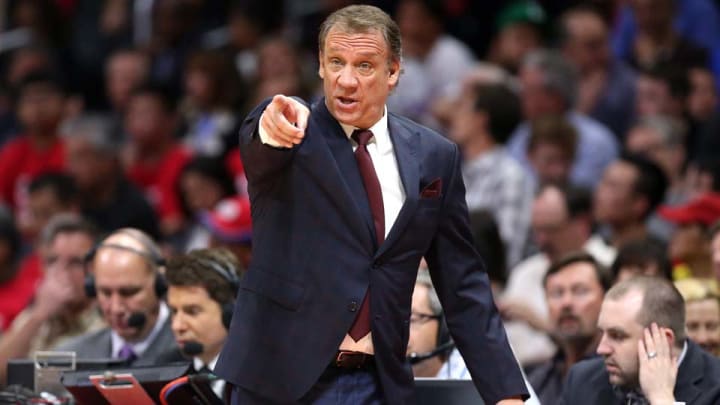The extensive reach of Flip Saunders

Flip Saunders was 5’11” but had the wingspan of a power forward, and exceptionally strong hands, fortified as a child by rubbing the pain from his mother’s muscles—she had polio—and shucking corn on summer jobs outside Cleveland. Those arms and hands helped him become Ohio’s Mr. Basketball as a high school senior and ensured, for the rest of his life, that little would exceed his reach or escape his grasp.
It didn’t hurt that he had long fingers. They helped him perform magic—he loved coin and card tricks—and to play point guard on a University of Minnesota team that featured future NBA stars Kevin McHale, Ray Williams and Mychal Thompson. But his greatest sleight-of-hand may have been conjuring an NBA coaching career out of the ether. “He always had this Walter Mitty idea that he’d be an NBA coach,” says Mike McCollow, who coached with Saunders in Rapid City, S.D. and Lacrosse, Wis. in the CBA. “And then he became one.”
Remembering Flip Saunders: Wolves head coach and president dies at 60
Before he coached the Timberwolves, Pistons and Wizards—and then the Timberwolves again—Saunders was a 24-year-old junior college coach at Golden Valley Lutheran College living with his wife, Debbie, on West 98½ Street in Bloomington, Minnesota. McCollow was 13 years old, and he dragged his best friend to the foot of Saunders’s driveway to dribble a basketball in the street after school, hoping the former Gopher star would eventually emerge. I was that best friend, and Flip—if only to make the dribbling stop—did come out to play with us, again and again.
When he died on Sunday, of Hodgkins lymphoma, at age 60, the basketball world mourned a famous coach with 654 wins and 592 losses over 17 seasons in the NBA. But that lifetime record is hardly the record of his lifetime.
It doesn’t show him, for instance, spending hours perfecting his Michael Jackson moonwalk to perform “Billie Jean” to three dozen kids at his basketball camp’s Friday afternoon talent show in the 1980s.
Timberwolves’ Kevin Garnett pays tribute to coach Flip Saunders
On his backyard half court in Bloomington, long before the NBA made him rich, Flip hosted a two-on-two basketball round-robin and barbecue that I named, as a high school kid, the Saunders Hoop Invitational Tournament. The winner of the S.H.I.T. was awarded a Cool Whip container covered in Reynolds Wrap, which we treated with all the reverence of the Larry O’Brien Trophy. Years later, when the Wolves were playing the Lakers in the 2004 Western Conference finals and I was covering the game for Sports Illustrated, Flip walked by and said: “You think the winner of this thing gets a Cool Whip container covered in tinfoil?”
He once sent me a note that said, “You’ve come a long way from the S.H.I.T.,” but the truth was that Flip had come farther and shone brighter than any of us—himself excepted—could imagine. In his three seasons in Detroit, Flip led the Pistons to three straight Eastern Conference finals. He led Minnesota to the brink of those 2004 NBA Finals before the Wolves succumbed to the Lakers. So despite the long arms and fingers, and those strangler’s hands, one bauble did escape his grasp, and that was the golden Larry O’Brien Trophy.
• SI Vault: Life on the Flip side (06.05.06)
But there were more important rewards. He and Debbie raised four children and a made a home in their beloved Minnesota, the state Flip never really left, no matter where his work took him. And anyway, there was a different trophy—a Cool Whip tub covered in Reynolds Wrap—that was a truer measure of the man. It was less shiny than the Larry O’Brien, but somehow more reflective.
